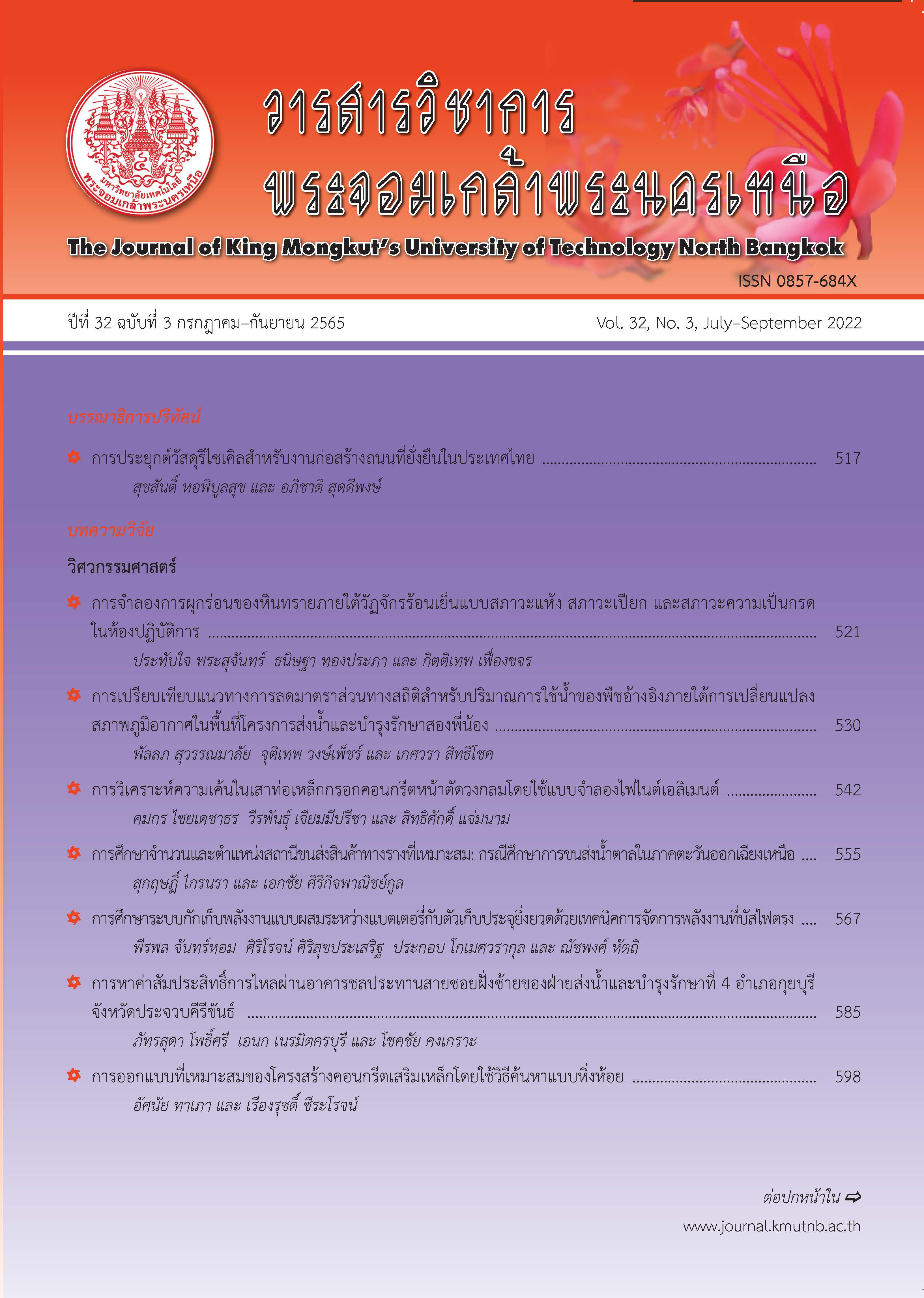The Influence of Lime Mud Waste from the Pulp and Paper Industry as a Replacement of Portland Cement Concrete on Properties of Concrete Masonry Units
Main Article Content
บทคัดย่อ
งานวิจัยนี้มีวัตถุประสงค์เพื่อศึกษาความเป็นไปได้ของการใช้กากปูนขาวทดแทนการใช้ปูนซีเมนต์ปอร์ตแลนด์บางส่วนในการผลิตคอนกรีตบล็อก โดยการศึกษาหาอัตราส่วนที่เหมาะสมของการแทนที่กากปูนขาวในอัตราส่วนร้อยละ 20-80 โดยน้ำหนัก เปรียบเทียบกับไม่มีการแทนที่ด้วยกากปูนขาว ศึกษาจำนวนสูตรผสม 5 สูตร ทำการขึ้นรูปคอนกรีตรูปทรงลูกบาศก์ จากการทดลองพบว่า การแทนที่กากปูนขาวร้อยละ 20 โดยน้ำหนัก (B-CM) ให้ค่าความหนาแน่นเฉลี่ยสูงที่สุด 1,973 กิโลกรัม/ลูกบาศก์เมตร ซึ่งให้ค่าความหนาแน่นที่สูงกว่าการไม่แทนที่ด้วยกากปูนขาว รองลงมาคือ สูตร C-CM ให้ค่าความหนาแน่น 1,928 กิโลกรัม/ลูกบาศก์เมตร จากการทดสอบความต้านแรงอัดแบบลดพื้นที่หน้าตัดของสูตรผสมที่มีการแทนที่ด้วยกากปูนขาว พบว่าความต้านแรงอัดเฉลี่ยสูงสุด 6.60 เมกะพาสคัล (B-CM) และ 4.02 (C-CM) จากการแทนที่กากปูนขาวร้อยละ 20 และ 40 โดยน้ำหนัก การแทนที่ด้วยกากปูนขาวบางส่วนสามารถช่วยปรับปรุงค่าความต้านแรงอัดให้มีค่าเพิ่มขึ้น ทำการขึ้นรูปคอนกรีตบล็อกรูปทรงขนาดมาตรฐานจากสูตร C-CM พบว่าให้ค่าความหนาแน่นเฉลี่ย 1,314.18 กิโลกรัม/ลูกบาศก์เมตร ให้ค่าการดูดกลืนน้ำเฉลี่ยสูงสุดร้อยละ 9.4 ค่าสัมประสิทธิ์ของการอิ่มน้ำ 1.03 ค่าความต้านแรงอัดเฉลี่ย 2.27 เมกะพาสคัล ซึ่งอยู่ในเกณฑ์มาตรฐานคอนกรีตบล็อกไม่รับน้ำหนัก มอก.58-2533
Article Details

อนุญาตภายใต้เงื่อนไข Creative Commons Attribution-NonCommercial-NoDerivatives 4.0 International License.
บทความที่ลงตีพิมพ์เป็นข้อคิดเห็นของผู้เขียนเท่านั้น
ผู้เขียนจะต้องเป็นผู้รับผิดชอบต่อผลทางกฎหมายใดๆ ที่อาจเกิดขึ้นจากบทความนั้น
เอกสารอ้างอิง
M. B. Al-Fakih, F. Nuruddin, and E. Nikbakht, “Development of interlocking masonry bricks and its’ structural behaviour: A review paper,” Earth and Environmental Science, vol. 140, no. 1, pp. 1–9, 2018.
M. Ali, R. J. Gultom, and N. Chouw, “Capacity of innovative interlocking blocks under monotonic loading,” Construction and Building Materials, vol. 37, pp. 812–821, 2012.
M. Madrid, A. Orbe, H. Carre, and Y. Garcia, “Thermal performance of sawdust and lime-mud concrete masonry units,” Construction and Building Materials, vol. 169, pp. 113–123, 2018.
E. A. W. Hendry, “Masonry walls: Materials and construction,” Construction and Building Materials, vol. 15, no. 8, pp. 323–330, 2001.
A. Thiwongkum, “Basic properties of concrete containing strength enhancing mineral admixture” M.S. thesis, Department of Engineering, Rajamangala University of Technology Thanyaburi, 2015 (in Thai).
N. P. Rajamane, M. C. Nataraja, and N. Lakshamanan, “An introduction to geopolymer concrete,” Journal of Indian Concrete, vol. 85, no. 11, pp. 25–28, 2011.
M. E. Nazar and S. N. Sinha, “Fatigue behaviour of interlocking grouted stabilised mud-fly ash brick masonry,” International Journal of Fatigue, vol. 29, no. 5, pp. 953–961, 2007.
S. I. Fundi, I. W. Kaluli, and J. Kinuthia, “Performance of interlocking laterite soil block walls under static loading,” Construction and Building Materials, vol. 171, pp. 75–82, 2018.
W. A. M. Thanoon, A.H. Alwathaf, J. Noorzaei, M. S. Jaafar, and M. R. Abdulkadir, “Finite element analysis of interlocking mortarless hollow block masonry prism,” Computers and Structures, vol. 86. no. 6, pp. 520–528, 2008.
M. Martínez and S. Atamturktur, “Experimental and numerical evaluation of reinforced drystacked concrete masonry walls,” Journal of Building Engineering, vol. 22, pp. 181–191, 2019.
W. Homsriprasert, “Durability of fly ash-based geopolymer mortar with electric ove curing under sodium sulfate and magnesium sulfate attack,” M.S. thesis, Department of Civil Engineering, Thammasat University, 2013 (in Thai).
Y. Sommanawat, “Utilizing sludge from water treatment plant and bagasse ash as combined pozzolanic material in cellular lightweight concrete production,” M.S. thesis, Department of Environmental Technology, Mahasarakham University, 2018 (in Thai).
Phoenix Pulp and Paper Public Company Limited. (June, 2019). Environment impact assessment. [Online]. Available: http://eia.onep.go.th /projectdetail.php?id=9571
D. Chaowarat, “Utilization of lime mud from pulp and paper industry as masonry and plastering mortar,” M.E. Thesis, Environmental Engineering, Graduate School, Khon Kaen University, 2004 (in Thai).
C. Ngohpok, V. Sata, and P. Chindaprasirt, “Sound absorption of pervious concrete containing various sizes of coarse aggregate,” KKU Research Journal, vol. 19, no. 2, 65–77, 2019.
M. Maggi, A. Orbe, E. Roji, and J. Cuadrado, “The effects of by-products incorporated in low-strength concrete for concrete masonry units,” Construction and Building Materials, vol. 153, pp. 117–128, 2017.

